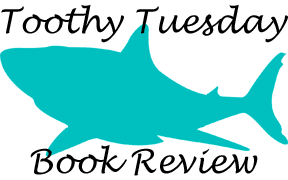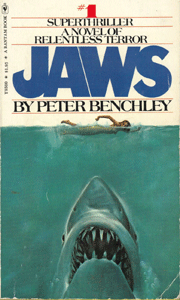Peter Benchley wrote “Jaws” (1974) before the boom of shark literature and films — indeed, his book and the subsequent Steven Spielberg movie (1975) launched the boom. But it still holds up today if you have the shark knowledge of a layperson, or if you want a time capsule of how people felt about the creatures a half-century ago.
More than a fish tale
It’s Benchley’s first book, and at times you can tell he’s a novice writer. He sometimes overwrites. Do we really need to know about the strength of Chief Brody’s urinal stream or all of Ellen Brody’s bodily preparations before embarking on a tryst with Hooper?
Maybe, maybe not. The hardboiled style is easy to read and it adds earthiness to the Amity police chief, environmental scientist Hooper, deep-sea fisherman Quint and the other characters. I found the sex sequence between Ellen and Hooper somewhat unnecessary but also creative — it’s actually Hooper describing what he plans to do, then we cut to the aftermath.

“Jaws” (1974)
Author: Peter Benchley
Series: “Jaws” No. 1
Genre: Horror thriller
Setting: Amity, N.Y., 1974
On Tuesdays this summer, Reviews from My Couch is highlighting classic (and not so classic) shark horror entertainment through the years.
At any rate, it colors the strained relationship between Brody and Hooper and adds even more tension to the climactic man-versus-shark sequence on the Orca.
It’s nice to have breaks between the shark attacks. Quint (who is as gruff as in the film, but who doesn’t give his famous USS Indianapolis speech) repeats himself a lot about how sharks are garbage-eating machines yet unpredictable. To catch one requires guesswork that comes from the gut.
The side plots provide a calm-before-the-storm vibe. Benchley’s writings of the attacks themselves are decent, but it’s in the build-up where “Jaws” shines — whether it’s speculation about the shark’s activities or Brody’s controversial decision to close the beach at Amity (a town on eastern Long Island, not in New England as I had imagined in my mind’s eye).
A tough decision
The question of whether to open or close the beach is black-and-white in the film: Brody is good because he wants to save lives, Mayor Vaughan is bad because he only cares about the bottom line. It’s more complex under Benchley’s pen. And the question resonates in the wake of the coronavirus pandemic of 2020-21, where local officials around the world had to decide whether to force businesses to close or to let them remain open.
Simply as a thought experiment, a strong case can be made for both lives and livelihoods. On top of that, in both “Jaws” and in the pandemic, there are further complications. One is the problem of limited data. Did the shark leave never to come back? Or did it leave only because the beaches were closed?

Another is political influence. Vaughan doesn’t merely want to keep the beaches open so he’ll be re-elected — after all, if more people are killed, that would hurt his chances of staying in office. Rather, he is under the thumb of the Mafia.
You might’ve heard this piece of “Jaws” trivia and thought Benchley’s book must be insane. But Vaughan’s situation is detailed and well explained. Indeed, Benchley writes cogently about a lot of topics. He either knows a lot about the subject or fakes it. (Except maybe the idea of a rape fantasy, which Ellen confesses to when flirting with Hooper. At the very least, this seems like a man trying to write a woman’s POV and misfiring.)
A former newspaper reporter, Benchley shows how small-town newspaper editors are only partially driven by the duty to share facts with readers. After all, a newspaper is a business, too. If editor Meadows plays up the first shark attack, that will limit tourism and hurt his business.
The Amity horror
Benchley’s writing about great white sharks is, of course, the main feast – and (although it seems a no-brainer in retrospect) Spielberg and company were smart to zero in on this aspect. It’s cinematic. (Interestingly, though, Benchley did not write “Jaws” with a movie in mind. He didn’t dream that a robotic shark could look real enough on screen.)
When the trio of men are on the water, Quint imagines that although the largest great white shark ever discovered was 34 feet long, there’s no reason to assume it’s the largest on the planet. He makes a case that megalodons could still exist — they simply have no reason to come to the surface, as their hunting grounds are in the deep. He suggests the megalodon is simply a larger version of a great white.
“Jaws” movie fans might gain a better understanding of the film’s details. For instance, the purpose of the yellow barrels is to keep the shark from swimming deeper and escaping. In the novel, Quint uses several rod-and-reel baits merely to draw the shark’s attention; he knows it’s a multi-step process to catch a beast of that size.
Benchley’s raw facts about sharks are compelling, but especially neat are his writings from the shark’s point of view. He illustrates that a great white shark is a machine, eating things because they are there, unable to distinguish what’s edible and what isn’t.
Humanity’s knowledge of sharks has increased since 1974, but not by so much that it dates this novel. It remains fascinating that the ocean contains monsters that will eat you. Benchley brings the palpable scariness of this fact to the surface.

